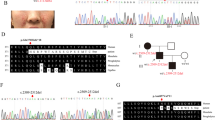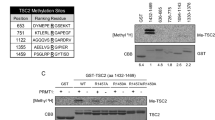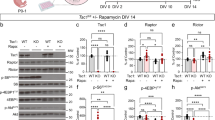Abstract
Tuberous sclerosis complex (TSC) is an autosomal dominant disorder characterised by the development of hamartomas in a variety of organs and tissues. The disease is caused by mutations in either the TSC1 gene on chromosome 9q34 or the TSC2 gene on chromosome 16p13.3. The TSC1 and TSC2 gene products, TSC1 and TSC2, interact to form a protein complex that inhibits signal transduction to the downstream effectors of the mammalian target of rapamycin (mTOR). Here we investigate the effects of putative TSC1 missense mutations identified in individuals with signs and/or symptoms of TSC on TSC1–TSC2 complex formation and mTOR signalling. We show that specific amino-acid substitutions close to the N-terminal of TSC1 reduce steady-state levels of TSC1, resulting in the activation of mTOR signalling and leading to the symptoms of TSC.
Similar content being viewed by others
Log in or create a free account to read this content
Gain free access to this article, as well as selected content from this journal and more on nature.com
or
References
Gomez M, Sampson J, Whittemore V eds: The Tuberous Sclerosis Complex. Oxford, UK: Oxford University Press, 1999.
Roach ES, DiMario FJ, Kandt RS et al: Tuberous sclerosis consensus conference: recommendations for diagnostic evaluation. National Tuberous Sclerosis Association. J Child Neurol 1999; 14: 401–407.
van Slegtenhorst M, de Hoogt R, Hermans C et al: Identification of the tuberous sclerosis gene TSC1 on chromosome 9q34. Science 1997; 277: 805–808.
The European Chromosome 16 Tuberous Sclerosis Consortium: Identification and characterization of the tuberous sclerosis gene on chromosome 16. Cell 1993; 75: 1305–1315.
Li Y, Corradetti MN, Inoki K et al: TSC2: filling the GAP in the mTOR signaling pathway. Trends Biochem Sci 2003; 28: 573–576.
Zhang H, Cicchetti G, Onda H et al: Loss of Tsc1/Tsc2 activates mTOR and disrupts PI3K-Akt signaling through downregulation of PDGFR. J Clin Invest 2003; 112: 1223–1233.
Kwiatkowski DJ, Zhang H, Bandura JL et al: A mouse model of TSC1 reveals sex-dependent lethality from liver hemangiomas, and up-regulation of p70S6 kinase activity in Tsc1 null cells. Hum Mol Genet 2001; 11: 525–534.
Nellist M, Sancak O, Goedbloed MA et al: Distinct effects of single amino acid changes to tuberin on the function of the tuberin–hamartin complex. Eur J Hum Genet 2005; 13: 59–68.
Jones AC, Shyamsundar MM, Thomas MW et al: Comprehensive mutation analysis of TSC1 and TSC2, and phenotypic correlations in 150 families with tuberous sclerosis. Am J Hum Genet 1999; 64: 1305–1315.
van Slegtenhorst M, Verhoef S, Tempelaars A et al: Mutational spectrum of the TSC1 gene in a cohort of 225 tuberous sclerosis complex patients: no evidence for genotype–phenotype correlation. J Med Genet 1999; 36: 285–289.
Au KS, Rodriguez JA, Finch JL et al: Germ-line mutational analysis of the TSC2 gene in 90 tuberous sclerosis patients. Am J Hum Genet 1998; 62: 286–294.
Dabora SL, Jozwiak S, Franz DN et al: Mutational analysis in a cohort of 224 tuberous sclerosis patients indicates increased severity of TSC2, compared with TSC1, disease in multiple organs. Am J Hum Genet 2001; 68: 64–80.
Sancak O, Nellist M, Goedbloed M et al: Mutational analysis of the TSC1 and TSC2 genes in a diagnostic setting: genotype–phenotype correlations and comparison of diagnostic DNA techniques in tuberous sclerosis complex. Eur J Hum Genet 2005; 13: 731–741.
Niida Y, Lawrence-Smith N, Banwell A et al: Analysis of both TSC1 and TSC2 for germline mutations in 126 unrelated patients with tuberous sclerosis. Hum Mutat 1999; 14: 412–422.
Au K-S, Williams AT, Roach ES et al: Genotype/phenotype correlation in 325 individuals referred for a diagnosis of tuberous sclerosis complex in the United States. Genet Med 2007; 9: 88–100.
Tuberous sclerosis database – Leiden Open Variation Database. [www.chromium.liacs.nl/lovd/index.php?select_db=TSC2].
NetGene2 Server. [www.cbs.dtu.dk/services/NetGene2].
SpliceSiteFinder. [www.genet.sickkids.on.ca/∼ali/splicesitefinder.html].
BDGP: Splice Site Prediction by Neural Network. [www.fruitfly.org/seq_tools/splice.html].
Nellist M, van Slegtenhorst MA, Goedbloed M et al: Characterization of the cytosolic tuberin–hamartin complex: tuberin is a cytosolic chaperone for hamartin. J Biol Chem 1999; 274: 35647–35652.
van Slegtenhorst M, Nellist M, Nagelkerken B et al: Interaction between hamartin and tuberin, the TSC1 and TSC2 gene products. Hum Mol Genet 1998; 7: 1053–1057.
Nellist M, Verhaaf B, Goedbloed MA et al: TSC2 missense mutations inhibit tuberin phosphorylation and prevent formation of the tuberin-hamartin complex. Hum Mol Genet 2001; 10: 2889–2898.
Jaeschke A, Hartkamp J, Saitoh M et al: Tuberous sclerosis complex tumor suppressor-mediated S6 kinase inhibition by phosphatidylinositide-3-OH kinase is mTOR independent. J Cell Biol 2002; 159: 217–224.
Jansen FE, Braams O, Vincken KL et al: Overlapping neurologic and cognitive phenotypes in patients with TSC1 or TSC2 mutations. Neurology 2008; 70: 908–915.
Lee-Jones L, Aligianis I, Davies PA et al: Sacrococcygeal chordomas in patients with tuberous sclerosis complex show somatic loss of TSC1 or TSC2. Genes Chromosomes Cancer 2004; 41: 80–85.
Goedbloed MA, Nellist M, Verhaaf B et al: Analysis of TSC2 stop codon variants found in tuberous sclerosis patients. Eur J Hum Genet 2001; 9: 823–828.
Hodges AK, Li S, Maynard J et al: Pathological mutations in TSC1 and TSC2 disrupt the interaction between hamartin and tuberin. Hum Mol Genet 2001; 10: 2899–2905.
Inoki K, Li Y, Zu T et al: TSC2 is phosphorylated and inhibited by Akt and suppresses mTOR signalling. Nat Cell Biol 2002; 4: 648–657.
Young JM, Burley MW, Jeremiah SJ et al: A mutation screen of the TSC1 gene reveals 26 protein truncating and 1 splice site mutation in a panel of 79 tuberous sclerosis patients. Ann Hum Genet 1998; 62: 203–213.
Dabora SL, Sigalas I, Hall F et al: Comprehensive mutation analysis of TSC1 using two-dimensional electrophoresis with DGGE. Ann Hum Genet 1998; 62: 491–504.
Pymar LS, Platt FM, Askham JM et al: Bladder tumour-derived somatic TSC1 missense mutations cause loss of function via distinct mechanisms. Hum Mol Genet 2008; 17: 2006–2017.
Acknowledgements
Financial support was provided by the US Department of Defense Congressionally-Directed Medical Research Program (grant no. TS060052) and the Michelle Foundation. We thank the family members who contributed to this study. Dr N Migone is thanked for helpful comments on the paper. The authors report no conflicts of interest.
Author information
Authors and Affiliations
Corresponding author
Additional information
Supplementary Information accompanies the paper on European Journal of Human Genetics website (http://www.nature.com/ejhg)
Supplementary information
Rights and permissions
About this article
Cite this article
Nellist, M., van den Heuvel, D., Schluep, D. et al. Missense mutations to the TSC1 gene cause tuberous sclerosis complex. Eur J Hum Genet 17, 319–328 (2009). https://doi.org/10.1038/ejhg.2008.170
Received:
Revised:
Accepted:
Published:
Issue date:
DOI: https://doi.org/10.1038/ejhg.2008.170
Keywords
This article is cited by
-
The Role of mTOR Inhibitors in the Treatment of Patients with Tuberous Sclerosis Complex: Evidence-based and Expert Opinions
Drugs (2016)
-
Genotype and cognitive phenotype of patients with tuberous sclerosis complex
European Journal of Human Genetics (2012)
-
Determining the pathogenicity of patient-derived TSC2 mutations by functional characterization and clinical evidence
European Journal of Human Genetics (2011)
-
Characterisation of TSC1 promoter deletions in tuberous sclerosis complex patients
European Journal of Human Genetics (2011)
-
Identification of a region required for TSC1 stability by functional analysis of TSC1missense mutations found in individuals with tuberous sclerosis complex
BMC Medical Genetics (2009)



